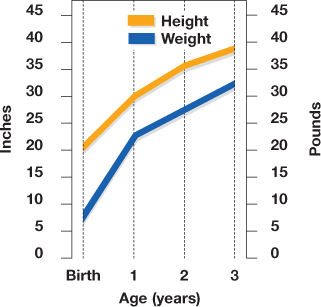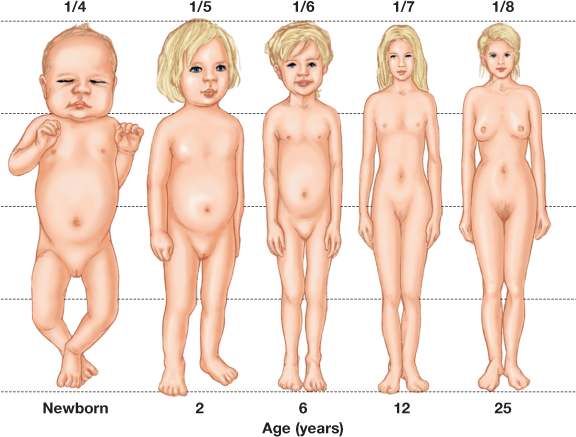Physical Growth: The Rapid Advances of Infancy
-
LO1How does the human body develop?
Infants grow at a rapid pace over the first two years of their lives (see Figure 5-1).By the age of 5 months, the average infant’s birth weight has doubled to around 15 pounds. By the first birthday, the baby’s weight has tripled to about 22 pounds. Although the pace of weight gain slows during the second year, it still continues to increase. By the end of his or her second year, the average child weighs around four times as much as he or she did at birth. Of course, there is a good deal of variation among infants. Height and weight measurements, which are taken regularly during physician’s visits during a baby’s first year, provide a way to spot problems in development.
Figure 5-1
Height and Weight Growth

Although the greatest increase in height and weight occurs during the first year of life, children continue to grow throughout infancy and toddlerhood.
The weight gains of infancy are matched by increased length. By the end of the first year, the typical baby grows almost a foot and is about 30 inches tall. By their second birthdays, children average a height of 3 feet.
Not all parts of an infant’s body grow at the same rate. For instance, as we saw first in Chapter 2, at birth the head accounts for one-quarter of the newborn’s entire body size. During the first two years of life, the rest of the body begins to catch up. By age 2 the baby’s head is only one-fifth of body length, and by adulthood it is only one-eighth (see Figure 5-2).
Figure 5-2
Decreasing Proportions

At birth, the head represents one-quarter of the neonate’s body. By adulthood, the head is only one-eighth the size of the body. Why is the neonate’s head so large?
There also are gender and ethnic differences in weight and length. Girls generally are slightly shorter and weigh slightly less than boys, and these differences remain throughout childhood (and, as we will see later in the book, the disparities become considerably greater during adolescence). Furthermore, Asian infants tend to be slightly smaller than North American Caucasian infants, and African American infants tend to be slightly bigger than North American Caucasian infants.
Following are four major principles (summarized in Table 5-1) that govern growth.
Table 5-1
The Major Principles Governing Growth
| Cephalocaudal Principle | Proximodistal Principle | Principle of Hierarchical Integration | Principle of the Independence of Systems |
|---|---|---|---|
| Growth follows a pattern that begins with the head and upper body parts and then proceeds to the rest of the body. Based on Greek and Latin roots meaning “head-to-tail.” | Development proceeds from the center of the body outward. Based on the Latin words for "near" and “far.” | Simple skills typically develop separately and independently. Later they are integrated into more complex skills. | Different body systems grow at different rates. |
-
The cephalocaudal principle states that growth follows a direction and pattern that begins with the head and upper body parts and then proceeds to the rest of the body. According to this principle, we develop visual abilities (located in the head) well before we master the ability to walk (closer to the end of the body).
-
The proximodistal principle states that development proceeds from the center of the body outward. With this principle, the trunk of the body grows before the extremities of the arms and legs. Development of the ability to use various parts of the body also follows the proximodistal principle. For instance, effective use of the arms precedes the ability to use the hands.
-
The principle of hierarchical integration states that simple skills typically develop separately and independently, but that these simple skills are integrated into more complex ones. Thus, the relatively complex skill of grasping something in the hand cannot be mastered until the developing infant learns how to control—and integrate—the movements of the individual fingers.
-
Finally, the principle of the independence of systems suggests that different body systems grow at different rates. For instance, the patterns of growth for body size, the nervous system, and sexual maturation are quite different.